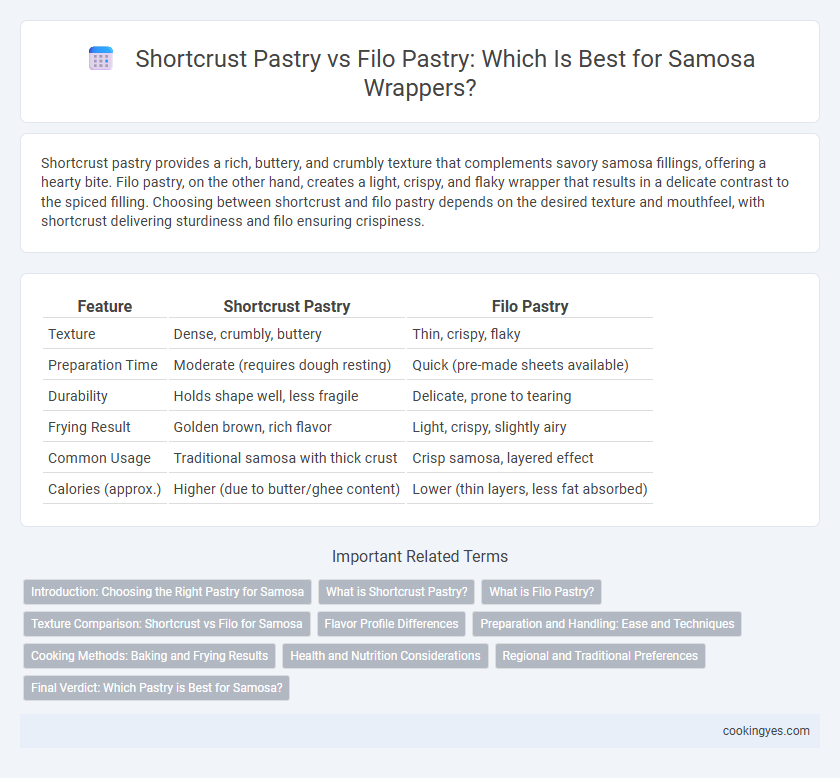Shortcrust pastry provides a rich, buttery, and crumbly texture that complements savory samosa fillings, offering a hearty bite. Filo pastry, on the other hand, creates a light, crispy, and flaky wrapper that results in a delicate contrast to the spiced filling. Choosing between shortcrust and filo pastry depends on the desired texture and mouthfeel, with shortcrust delivering sturdiness and filo ensuring crispiness.
Table of Comparison
| Feature | Shortcrust Pastry | Filo Pastry |
|---|---|---|
| Texture | Dense, crumbly, buttery | Thin, crispy, flaky |
| Preparation Time | Moderate (requires dough resting) | Quick (pre-made sheets available) |
| Durability | Holds shape well, less fragile | Delicate, prone to tearing |
| Frying Result | Golden brown, rich flavor | Light, crispy, slightly airy |
| Common Usage | Traditional samosa with thick crust | Crisp samosa, layered effect |
| Calories (approx.) | Higher (due to butter/ghee content) | Lower (thin layers, less fat absorbed) |
Introduction: Choosing the Right Pastry for Samosa
Shortcrust pastry offers a rich, buttery texture that provides a sturdy and crumbly shell for samosas, enhancing the overall flavor with its dense, melt-in-the-mouth consistency. Filo pastry, in contrast, is thin, crispy, and flaky, delivering a lighter, crunchier wrapper that crisps beautifully when fried or baked, creating a delicate outer layer. Selecting between shortcrust and filo pastry fundamentally impacts the samosa's texture and mouthfeel, catering to preferences for a hearty or airy pastry experience.
What is Shortcrust Pastry?
Shortcrust pastry is a type of dough made from a simple mixture of flour, fat (usually butter or ghee), and water, creating a crumbly and tender texture ideal for samosa wrappers. This pastry offers a rich, buttery flavor and provides a sturdy yet flaky shell that holds savory fillings without becoming soggy. Compared to filo pastry, shortcrust is thicker and less delicate, giving samosas a satisfying bite and golden, crisp finish after frying or baking.
What is Filo Pastry?
Filo pastry is an ultra-thin, unleavened dough used in various Mediterranean and Middle Eastern dishes, known for its crisp, flaky texture when baked or fried. Unlike shortcrust pastry, filo consists of multiple delicate layers brushed with butter or oil to achieve a light, crunchy samosa wrapper. Its paper-thin sheets allow for a crispier, less dense samosa exterior compared to the sturdier, crumbly texture of shortcrust pastry.
Texture Comparison: Shortcrust vs Filo for Samosa
Shortcrust pastry offers a dense and crumbly texture that provides a rich bite, making it ideal for samosas requiring a sturdier wrapper. Filo pastry delivers an ultra-thin, flaky, and crispy texture that results in a delicate crunch, enhancing the crispiness of the samosa exterior. Texture preference depends on whether a firm, buttery shell or a light, crisp layer is desired for the samosa experience.
Flavor Profile Differences
Shortcrust pastry offers a rich, buttery flavor and a dense, crumbly texture that complements savory samosa fillings with a hearty mouthfeel. Filo pastry provides a light, crisp, and flaky shell with a subtle, neutral taste that allows the spices and aromas of the filling to stand out prominently. Choosing between shortcrust and filo pastry impacts the overall flavor balance, with shortcrust adding depth and filo emphasizing crispiness and delicate texture.
Preparation and Handling: Ease and Techniques
Shortcrust pastry offers a sturdy and forgiving dough ideal for samosas, allowing easier rolling and shaping without tearing due to its balanced fat-to-flour ratio. Filo pastry requires careful handling and meticulous layering to prevent crisp breakage, demanding more precision and swift assembly to maintain its delicate texture. Preparation with shortcrust pastry suits home cooks prioritizing durability, while filo pastry caters to those seeking an ultra-crispy, flaky samosa wrapper through expert technique.
Cooking Methods: Baking and Frying Results
Shortcrust pastry samosas yield a buttery, crumbly texture when baked, offering a less oily alternative with a golden, firm crust that crisps evenly. Filo pastry samosas, whether baked or fried, produce a lighter, flakier shell with multiple thin, crisp layers that deliver a delicate crunch and absorb less oil during frying. Baking filo samosas reduces greasiness while maintaining crispness, whereas frying shortcrust samosas enhances richness but increases oil content and creates a more substantial bite.
Health and Nutrition Considerations
Shortcrust pastry samosas tend to be higher in fat and calories due to the butter or shortening used, impacting heart health when consumed frequently. Filo pastry offers a lighter option with lower fat content and fewer calories, making it better suited for a health-conscious diet. Both choices affect texture and crispness, but filo pastry's thin layers also contribute to reduced oil absorption during frying or baking.
Regional and Traditional Preferences
In North Indian and Pakistani cuisine, samosas traditionally use shortcrust pastry for a rich, crumbly texture that holds a spiced potato or meat filling. In contrast, Bengali and some Middle Eastern versions prefer filo pastry, creating a lighter, flakier casing that crisps up during frying or baking. Regional preferences highlight the divergent culinary traditions: shortcrust pastry aligns with hearty, rustic flavors, while filo pastry caters to delicate, crisp textures favored in Eastern and Mediterranean samosa adaptations.
Final Verdict: Which Pastry is Best for Samosa?
Shortcrust pastry offers a rich, buttery texture that creates a sturdy yet tender shell for samosas, enhancing the overall flavor and holding up well to frying. Filo pastry delivers a lighter, crispier, and flakier wrapper, perfect for those seeking a less greasy and more delicate bite. For the best samosa experience, shortcrust pastry is ideal for a traditional, robust texture, while filo caters to a lighter, crunchier alternative depending on preference.
Shortcrust Pastry vs Filo Pastry for samosa wrapper Infographic

 cookingyes.com
cookingyes.com